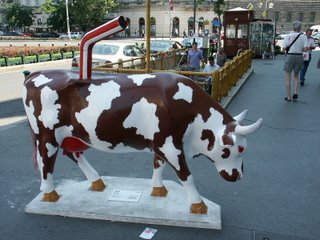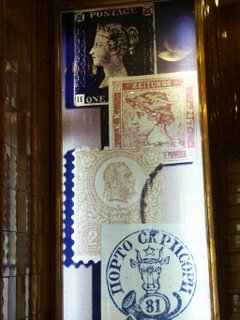 Ever wonder where chocolate milk comes from?
Ever wonder where chocolate milk comes from?
Today was a late starter day, which would have insured some student deciding for join me, but not find me where I should be. It was not until 11:30 am that Ron and I arrived at the Ferenc Liszt Memorial Museum. It is located in the VI district at Vőrősmarty utca 35. This is one stop beyond Oktogon on the M1 metro going in the direction of Heroes Square. Alas, no students in sight, so all of my excuses for being late were safely tucked away for use on another occasion. The timing for this museum was excellent. In two days, they will be closed until September 2nd for renovations.
Entrance fees were 400 Huf each and if I had sported for one, a photography ticket was an additional 750 Huf. Taking into consideration the few bucks here and there that this adventure is costing, I am becoming more frugal with making the decision to buy photography tickets.
I get lots of jeers when I share that I am not a music buff, especially not classical music, so visiting this museum was stretching my envelope. I have to admit that I did learn something tidbit of trivia. I had heard that Liszt was Austrian, but since he had spent so much time here in Hungary, the Hungarian claimed him. The truth is that he was born in Hungary, but in 1920, that village became part of Austria. Another mystery solved.
Liszt had three residences: one in Austria, one here in Budapest, and another in Italy. He spent three months of the year here and established the music academy where he presided as President until his death. The museum is his residence in Budapest. It is small considering he had a wife and three children, gave music lessons in one room, and worked here.
One walks into a hallway, now the cashier’s desk, but which is decorated with paintings and busts. Directly ahead is a small room that is filled with a piano. The laminated handout gives some information about who is pictured in the photos and other décor in the room. It is not explicit enough to be of interest. All of the signs on the walls are in Hungarian and German, but not English.
To the right of this room is a large room with various piano type instruments, but not full pianos. These were gifts to Liszt from various people.
The room to the left of the center is a large room with furniture, another piano, more décor from Liszt’s life and work. What I found most impressive was a silver music stand on the piano with the bust of famous musicians who predated Liszt. The artwork was splendid with little musical instruments on either side gracing the stand.
If one was a Liszt aficionado, this would be necessary to see museum, but for those like me, it was interesting, but there will never be a need to return.
The next stop was the Stamp Museum, which is housed at Hársfa utca 47 in the VII district. Web site tourist directions showed this as being close to the M1 metro at the Vőrősmarty utca stop also, but it is actually closer to the 4 or 6 tram stop at Wesselényi. The only other stamp museum I had ever been to was in Philadelphia back when I helped Ben Franklin put together his collection for display. It was my expectation to see a few dozen glass topped display cases with collections of stamps in them. Was I in for a shock!
After paying my insignificant entrance fee of 200 Huf and my disappointing discovery that no photographs were allowed at all, I ventured up the stairs within a beautifully tiled staircase. Walking into a lobby, the entrance is blocked by glass doors. I became the focus of attention for the four attendants working. When they questioned my language, I was provided with a sheet of English highlights to the collection.
Even with the English, I was a bit confused as to where to begin, but the ever ready woman was thrilled to assist. Along three long walls, the collection is broken into ‘blocks’. Each block is number. Within each block are thin drawers that are vertical, not horizontal. She instructed me as to how to pull out the drawer completely so it would rest on its back corner. Within each drawer were three pages of stamps on either side. Each page artistically placed to perfection on graph paper, allowed each stamp or sheet of stamps to tell their story without interruption.
When I pulled the first drawer out myself, I did not pull it out completely. I had this mental image of pulling it out of the wall. The lovely lady noticed and came to reassure me with hand gestures, that I could indeed pull it out fully to see all three pages. To the right or left of each block there is a ‘Table of Contents’ of each drawer that includes the country and the years the stamps were issued. There are hundreds of drawers dedicated to Hungarian stamps from the very first stamps up to 1998. The second and third walls have stamps from all over the world. One of the highlights were stamps from Gabon where they are coins. Others are irregular shapes, all of them masterpieces in miniature. The world’s largest stamp issued came from, of course, the U.S.
where they are coins. Others are irregular shapes, all of them masterpieces in miniature. The world’s largest stamp issued came from, of course, the U.S.
The woman went into a little room and then called me in. There is a special exhibit of stamps that have to be viewed with a large powered magnifying glass and special lighting. She set the machine to English and then left drawing the curtain. I had to manually move the magnifying glass as the narration spoke looking at the highlights of the stamps as she spoke.
When I emerged from the little room, the woman had pulled the drawers of the other highlights on the list. I thought perhaps that I was keeping them from closing, so I started to rush through at that point. In addition, there are many glass displays with other stamp memorabilia, but only in Hungarian. Feeling a bit rushed, though having been there about two hours already, I was ready to call it quits for the day. For 200 Huf, I could certainly return another time, though not taking photos did squelch my enjoyment a tad. Having some remembrances of many of these masterpieces of artwork other than my memory would have been spectacular.
The cashier must have realized my disappointment in not being able to take pictures. He allowed me to photograph the basically unadorned lobby. This was my only shot.
Thursday, July 20, 2006
Today was a late start
Posted by
Anonymous
at
5:12 PM
![]()
![]()
Labels: Austria, Budapest, Classical music, English language, German language, Hungary, Photography, United States
Subscribe to:
Post Comments (Atom)
![Reblog this post [with Zemanta]](http://img.zemanta.com/reblog_e.png?x-id=e8d28ab5-a1d6-49b4-aa70-14c49e087e24)















0 comments:
Post a Comment